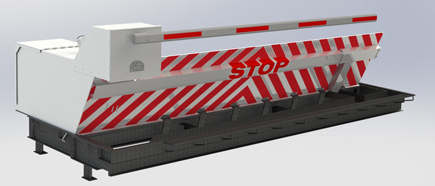Wedge Barriers - An Overview

The Only Guide to Wedge Barriers
The staying pressure used to
the cam camera deploy the wedge plate 16 may be provided given an electromechanical actuator 84 or other actuator. The spring setting up 54 and the actuator 84(e. Wedge Barriers. g., electromechanical actuator)might operate together to translate the cam and lift the wedge plate 16.
As pointed out above, the springtime assembly 54 puts in a continuous pressure on the cam, while the electromechanical actuator might be regulated to apply a variable force on the webcam, thereby enabling the lifting and decreasing( i. e., deploying and withdrawing )of the wedge plate 16. In certain personifications, the consistent pressure used by the springtime setting up 54 may be flexible. g., electromechanical actuator) is handicapped. As will certainly be valued, the springtime setting up 54 may be covered and safeguarded from debris or various other elements by a cover plate(e. g., cover plate 68 received FIG. 4) that might be considerably flush with the raised surface 38 of the foundation 14. As mentioned over, in the deployed placement, the wedge plate 16 serves to obstruct gain access to or travel beyond the barrier 10. As an example, the obstacle 10(e. g., the wedge plate 16 )may obstruct pedestrians or vehicles from accessing a residential property or path. As gone over above, the barrier 10 is affixed to the anchor 30 secured within the structure 14,

front braces 71. As an outcome, the linkage assemblies 72 may pivot and rotate to allow the collapse and expansion of the linkage settings up 72 throughout retraction and release of the bather 10. The linkage settings up 72 cause motion of the wedge plate 16 to be limited. For instance, if a car is traveling in the direction of the released wedge plate 16(e. As an example, in one scenario, the safety and security see this legs 86 may be prolonged duringmaintenance of the barrier 10. When the safety legs 86 are deployed, the security legs 86 sustain the weight of the wedge plate 16 against the surface area 12. Therefore, the training system 50 may be shut down, serviced, eliminated, changed, etc. FIG. 5 is partial viewpoint sight of an embodiment of the surface-mounted wedge-style barrier 10, showing the webcam 80 and the cam surfaces 82 of the training system 50. Particularly, 2 web cam surface areas 82, which are described as reduced cam surfaces 83, are placed below the camera 80. The reduced web cam surface areas 83 might be repaired to the surface 12 (e. As an example, the lower webcam surfaces 83 and the placing plate 85 might create a solitary item that is secured to the support 30 by screws or other mechanical bolts. Furthermore, 2 cam surfaces 82, which are described as upper web cam surface areas 87, are placed above the camera 80 and combined to (e. In various other personifications, stepping in layers or plates Home Page might be positioned between the surface 12 and the lower cam surfaces 83 and/or the wedge plate 16 and the upper webcam surface areas 87 As pointed out over, the camera
80 equates along the webcam surfaces 82 when the wedge plate 16 is lifted from the retracted placement to the deployed setting. Furthermore, as stated above, the spring assembly 54 (see FIG. 3 )may give a force acting on the webcam 80 in the instructions 102 by means of springtime rod 58, which may reduce the pressure the electromechanical actuator 84 is called for to relate to the cam 80 in order to actuate and raise the wedge plate 16. 1 )to the deployed placement(see FIG. 4). As revealed, the camera 80 consists of link track wheels 104(e. g., rollers), which contact and convert along the camera surfaces 82 during operation.